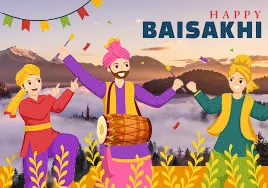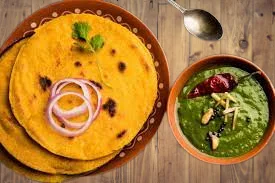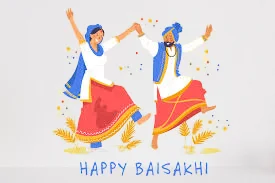Vaisakhi festival is celebrated to mark the onset of spring in India. The time of Baisakhi usually signifies the end of the harvest season, and is an occasion of tremendous joy and festivity for farmers. The celebrations are concentrated in the states of Punjab and Haryana.
Vaisakhi 2023
Vaisakhi, also pronounced Baisakhi as well as Basoa marks the first day of the month of Vaisakh and is traditionally celebrated annually on 13 April and sometimes 14 April. This year in 2023, Vaisakhi will be celebrated on 14th April, Friday. It is seen as a celebration of spring harvest primarily in Northern India.
Vaisakhi as a major Sikh festival marks the birth of the Khalsa order by Guru Gobind Singh, the tenth Guru of Sikhism, on 13 April 1699.

Baisakhi was one of the three festivals that the third Sikh Guru, Guru Amar Das, chose to be celebrated by the Sikhs. In 1699, the ninth Sikh Guru, Guru Teg Bahadur, was publicly beheaded by the Mughals. This occurred due to his willingness to oppose the Mughal invaders and protect the cultural identity of Hindus and Sikhs whom the Mughal ruler Aurangzeb wanted to convert to Islam. On Baisakhi day of 1699, his son, Guru Gobind Rai, rallied the Sikhs and inspired them through his words and actions, bestowing upon them and himself the title of Singh or lion, thus becoming Guru Gobind Singh.
The five Ks of Sikhism were adopted, and the Guru system was dispelled, with Sikhs being urged to accept the Granth Sahib as the eternal guide. Thus, the festival of Baisakhi is observed as the coronation of the last Sikh Guru, Guru Gobind Singh, as well as the foundation of the Khalsa Panth of Sikhism, granting it a position of immense importance to Sikhism, and is one of the biggest Sikh festivals.
The 5 Ks date from the creation of the Khalsa Panth by Guru Gobind Singh in 1699. The 5 Ks taken together symbolise that the Sikh who wears them has dedicated themselves to a life of devotion and submission to the Guru. The 5 Ks are 5 physical symbols worn by Sikhs who have been initiated into the Khalsa.
The Five K’s are the markers of Sikh identity, and they consist of: uncut hair, a short sword or knife, a steel wristband, a wooden comb, and shorts worn as an undergarment. The observance of the Five K’s was originally the mark of the Khalsa.
Vaisakhi was also the day when Bengal Army officer Reginald Dyer orders his troops to shoot into a protesting crowd, an event which would come to be known the Jallianwala Bagh massacre; the massacre proved influential to the history of the Indian independence movement.
Significance
Baisakhi is a festival celebrated by Sikhs, with both religious and harvest significance. It marks the formation of the Khalsa (the pure one) which occurred on Vaisakhi day in 1699, established by Guru Gobind Singh, the tenth and last Sikh Guru. On this day, Guru Gobind Singh abolished the distinction between higher and lower caste communities, proclaiming equality for all human beings. Eventually, the Sikh Guru tradition came to an end, with the Guru Granth Sahib being declared the eternal guide and Holy Book of Sikhism, according to Drik Panchang.
Celebration
Baisakhi is a significant festival celebrated as Sikh New Year or Punjabi New Year. It is also considered the solar New Year for Hindus. The day is marked by various cultural events and fairs, and Sikhs commemorate their tenth guru, Guru Gobind Singh. The festival is also a time when Gurdwaras organize special prayers in honor of the rabi crop harvest. Baisakhi is primarily celebrated by Hindus in Punjab, Haryana, and western Uttar Pradesh.
The Sikhs celebrate Baisakhi by bathing in the holy river and visiting the Gurudwaras, where they take part in the prayers held during the day. Baisakhi gets everyone into the festive mood, and people like to dance their heart out. Special celebrations occur at the Talwandi Sabo, where Guru Gobind Singh recompiled the sacred Granth Sahib, the Gurudwara at Anandpur Sahib, where Khalsa was born, and the Golden Temple in Amritsar. Farmers thank God for the bountiful harvest and pray for prosperity in the coming year. The phrase ‘Jatta Aayi Baisakhi’ is loudly declared across the fields by gleeful farmers as they passionately dance in celebration, an exciting way of greeting the festival.
After the prayers or Ardas, the Karah Prasad is offered to the guru and then distributed among the people. This is followed by a special guru-ka-langur or community lunch at the Gurudwaras, following which the procession of Nagar Kirtan is carried out through the streets, where devotional songs are sung by all in honour of this sacred observance, while revellers take the celebration with the enthusiastic and vibrant display of song and dance in the most colourful garb.
Dress
As a celebration of the new spring, Vaisakhi is an occasion that sees men, women and children commemorate this joyous occasion by buying new attire, picking the most lively and dynamic of the lot to reflect the atmosphere of happiness felt throughout the crowd. Traditional Punjabi attire for men includes the turban with the fan-like adornment worn with a kurta, a waistcoat, the rumaal or scarf, and the lungi tied around their waist, while the women wear the customary garments of Salwar Kameez with the most festive and ostentatious jewellery. The multi-coloured brilliance of this attire reflects the perky and bubbly nature of the Punjabi way of living.
Food
Multiple food stalls are set up at the Baisakhi fairs to keep the crowds refreshed and energised as they party all night. Quintessentially Punjabi cuisine like Chhole Bature, Achari mutton, Chicken saagwala, Sarson ka saag, kadhi chawal, dry fruit kheer and the famous lassi are ever-present at the fair.

These gastronomic delights are representative of the great love of food and flavour displayed by the people of Punjab.
Dances
The traditional dances of Bhangra and Gidda are performed during Baisakhi to the beat of the drums in open fields creating an atmosphere of zest and joy. At some places, fairs are held where people bring out their happiness and perform acrobatics. Men, women and children adorn themselves in colourful clothes and jewellery while they excitedly participate in the festivities.

The Baisakhi Procession, also known as Nagar Kirtan, is an important part of the celebrations in Punjab. The most sacred scripture Granth Sahib is taken out with honour by traditionally dressed Panj Piaras, also known as the five senior religious Sikhs, and an important part of the Khals traditions. Baisakhi processions move through the streets and lanes of the city, accompanied by music, singing and chanting of scriptures and hymns. A large number of devotees participate in the Baisakhi processions.
During the Baisakhi processions, children and youth demonstrate their skills in martial arts along with the drummers and bands around, and men swinging swords making the event more colourful. All in all, it’s safe to say that each year, the festival of Baisakhi marks a new chapter in the life of people.
Facts
1. The day of Vaisakhi marks the birth of Khalsa Panth and therefore holds tremendous significance for the Sikhs.
2. The day of Baisakhi Festival is also important for the Hindus as it on this day in 1875 that Swami Dayanand Saraswati founded the Arya Samaj .
3. It was on the day of Baisakhi in 1567 that Guru Amar Das had first institutionalized Baisakhi as one of the special days when all Sikhs would gather to receive the guru’s blessings at Goindwal.
4. For the Buddhist, the day of Baisakhi Festival is significant, as according to a popular legend it was on this auspicious day that Gautam Buddha attained enlightenment or Nirvana under the Mahabodhi tree in the town of Gaya.
5. It was on the Vaisakhi Day meeting organized at Anandpur Sahib, in 1699, that the tenth Guru of Sikhs, Guru Gobind Sigh laid the foundation of Khalsa Panth.
6. It was on the Baisakhi Day that Guru Gobind Singh administered amrit (nectar) to his first batch of five disciples, the Panj Piaras making them Singhs, a martial community.
7. After the Vaisakhi Day in 1699 the tradition of gurus was discontinued, and the Granth Sahib – the Holy book of the Sikhs was declared the eternal guide of the Sikhs.
8. Vaisakhi date coincides with ‘Rongali Bihu’ in Assam, ‘Naba Barsha’ in Bengal, Puthandu in Tamil Nadu and ‘Pooram Vishu’ in Kerala.